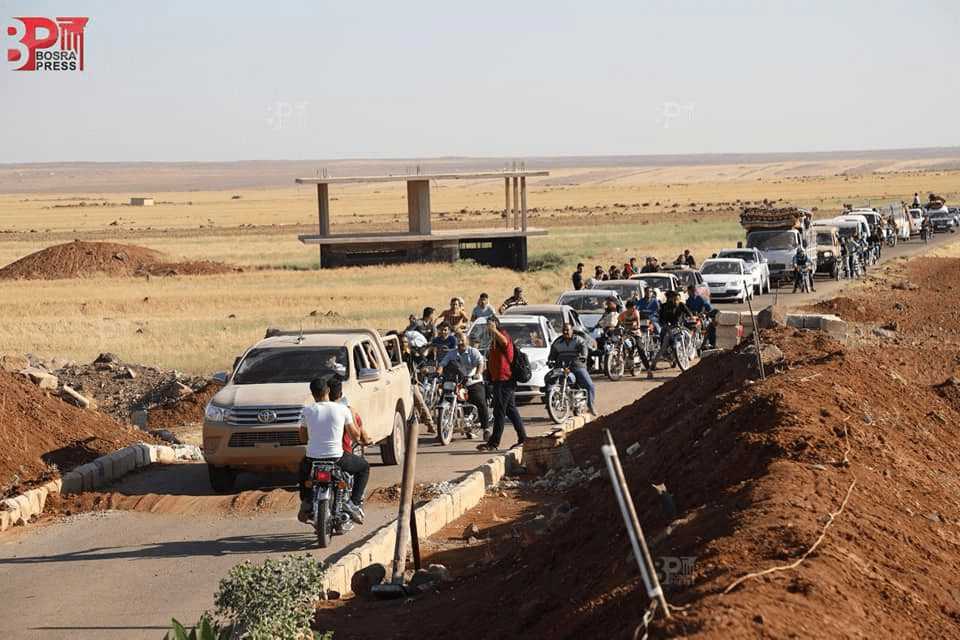Syrian army takes control of most of Jordanian border as Daraa rebels await reconciliation
Displaced Syrians return to their homes in Busra a-Sham after […]
9 July 2018
Displaced Syrians return to their homes in Busra a-Sham after pro-government forces captured the Naseeb border crossing on Saturday. Photo courtesy of Bosra Press.
AMMAN: Syrian army units took control of a roughly 50-kilometer stretch of the Syrian-Jordanian border from opposition forces on Sunday, the latest step in a Russian-negotiated settlement for the Syrian government to retake control of the majority of the country’s southwest.
Syrian government soldiers took control of “all of the Free Syrian Army (FSA)-controlled border zone” on Sunday evening, one southern rebel commander told Syria Direct on condition of anonymity as he was not authorized to speak to the press.
Sunday’s handover of territory by southern rebels puts pro-Syrian government forces in control of nearly the entire Syrian-Jordanian border for the first time since 2012 after a major Damascus-led campaign against rebels in the country’s southwest began last month.
Under an agreement signed by opposition and Russian negotiators in Syria’s southwestern Daraa province on Friday, local rebels will reportedly surrender all of their heavy weapons to government forces in several stages over the coming weeks.
Opposition fighters who agree to reconcile their status with the government will form local “security forces”—alongside Russian military police—in roughly a dozen recently government-captured towns and villages in eastern Daraa province. Any fighters unwilling to reconcile will be given the option to relocate to Syria’s opposition-controlled northwest.
Pro-government forces are also set to withdraw from much of Daraa’s eastern countryside under the agreement, pulling back from recently captured territory and allowing newly formed rebel security forces to re-enter and oversee the reconciliation process.
So far, no withdrawal has taken place, the opposition commander said.
Syria Direct could not independently confirm the final terms of the reported agreement, which were distributed online by pro-opposition activists since the weekend. Official rebel spokespeople did not respond to requests for comment.
Friday’s reconciliation agreement came three weeks into a massive Syrian government-led air and ground assault on rebel-held territory in southwestern Syria’s Daraa, Suwayda and Quneitra provinces that has seen the majority of the region fall under government control and more than 300,000 local residents displaced.
After last week’s settlement, only an Islamic State (IS) affiliate in the Yarmouk Basin, a valley nestled between the Israeli-occupied Golan Heights and Jordan, and a collection of rebel factions in northwestern Daraa province have yet to reconcile with Damascus.
But even amongst rebels who have agreed to Friday’s deal it is unclear precisely how the terms of the deal will unfold in the coming days. In conversations with more than half a dozen rebel commanders, fighters and negotiators on Sunday and Monday, all said that despite the reconciliation deal, a sense of confusion and uncertainty hangs over Daraa.
“We’re waiting to see where we’ll end up,” the anonymous rebel commander, whose faction signed Friday’s reconciliation deal, told Syria Direct on Monday.
“No one knows what’s happening—it’s in God’s hands,” he added.
‘Joining Syria and Jordan’
Hours after opposition factions signed onto Friday’s reconciliation agreement, SAA soldiers and armored vehicles entered the Naseeb border crossing along the Syrian-Jordanian border on Saturday, where upwards of 100,000 displaced Syrians from across Daraa’s eastern countryside had gathered.
The Naseeb crossing, which links the Jordanian and Syrian capitals along a major international highway, was worth billions of dollars in trade before the Syrian war broke out in 2011. Both Damascus and Amman have long eyed a resumption of international trade, a Jordanian military official told BBC Arabic in 2016.
Just north of the Naseeb crossing, government workers began clearing debris and wreckage from the main highway joining Damascus and the Jordanian border on Monday, Syrian state news outlet SANA reported.
The road clearing, along with the reconstruction of destroyed section of Damascus-Amman highway, will continue until the highway “resumes its critical function in joining Syria and Jordan,” Syrian government official Ahmad Zein al-Abedein told SANA.
As many as 60,000 displaced Syrians who had gathered at the Naseeb crossing returned to their homes in Daraa’s eastern countryside over the weekend, the UK-based, pro-opposition Syrian Observatory for Human Rights (SOHR) reported.
Photos posted online by pro-opposition media outlets appeared to show large convoys of displaced people returning to the city of Busra a-Sham in eastern Daraa province on Sunday. Last week, rebel forces from Busra a-Sham—notably Shabab a-Sunnah, led by commander Ahmad al-Awdeh—were among the first to formally agree to a reconciliation deal with the government.
Only 150–200 displaced Syrians remained near the Naseeb crossing on Monday, UN official Anders Pedersen told Jordanian state news on Sunday.
But in rebel-held Quneitra and northwestern Daraa province, rebel factions appear to be digging in and refusing reconciliation—for now.
Rebel officials in western Daraa countryside announced via social media on Saturday that 11 rebel factions there had merged into Jaish al-Janoub, or the Southern Army.
The decision to form Jaish al-Janoub stemmed from “the necessity for military and political unity” in the current “dangerous phase” of the revolution, said Saturday’s online statement.
An opposition commander with Jaish al-Janoub told Syria Direct on Monday that rebel fighters were still “stationed on the frontlines” with pro-government forces, but were not sure what would happen next.








